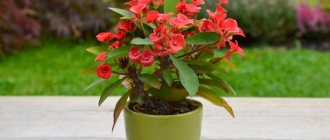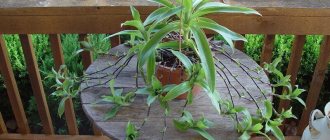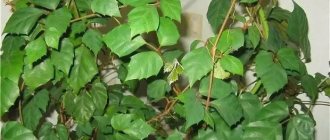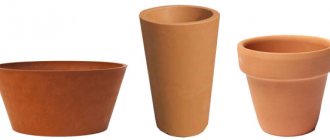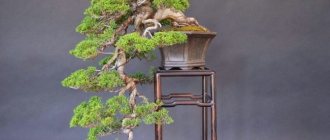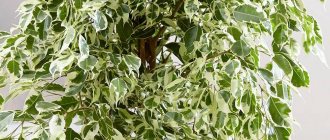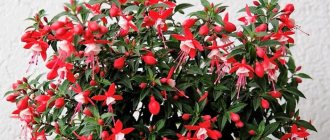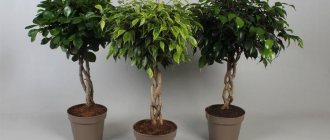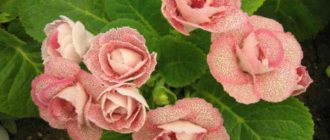Overseas guest - Euphorbia Belozhilkovy (white-lobed) care and photo
White-veined spurge is the most common of the spurges grown indoors.
It is sometimes called a cactus because of its thick stem, and sometimes a palm because of the lush foliage at the top of the trunk.
White-headed spurge is often confused with comb spurge.
To correctly determine the species, you need to pay attention to the veins . In the white-veined one they are clearly expressed, and besides, the white-veined one has the appearance of a palm tree, it is the most decorative.
Possible problems in cultivation and diseases
White-veined milkweed grows and reproduces well when cared for at home. However, there are some diseases and pests that worsen the condition of the plant and can lead to its death.
Drops buds and leaves
Some gardeners are wondering why the leaves began to fall. This fact may indicate insufficient lighting. There are two ways to correct the situation. The flowerpot is moved closer to the window. If this is not possible, you should use a lamp.
The leaves are turning pale
A dull shade of leaves and the appearance of pale spots on the leaf blade may indicate a violation of the watering regime or inappropriate lighting.
The tips of the leaves are drying out
When dry ends appear, you should pay attention to the temperature regime. Perhaps the flower is exposed to hypothermia or is standing in drafts.
The lower leaves fall off
Often the lower leaves of milkweed begin to turn yellow and fall off if the roots rot. To check this, remove the flower from the pot and examine the roots. If necessary, the root system is washed and damaged parts are removed.
Aphids on milkweed
Description
Milkweed is native to Madagascar . Now it is found in subtropical America and Africa.
Stem
The lower part is round, dense, thin. It thickens at the top, becomes ribbed, usually has 4-5 ribs, along the edge of which there are fringed stipules. Gradually, with growth, the trunk becomes exposed from below. With proper care, the indoor flower white-veined (white-veined) spurge can grow up to two meters.
Leaves
The dark yellow leaves have white veins, grow on long petioles that have a reddish color, they themselves are also long, up to 20 cm.
Young leaves grow at the top, on the crown, which makes the plant look like a palm tree.
Flower
Flowering is not one of the advantages of this succulent.
The bracts consist of hard scales, from which flowers look like thin white threads. In general, the flower looks extremely inconspicuous.
After flowering ends, a box remains with three nests inside where the seeds ripen. After the seeds have fully ripened, it cracks, the seeds are scattered in different directions and germinate quickly in all nearby pots. For this reason, spurge is also popularly called “ champagne splash.” If there is a need to collect seeds, then you need to monitor the maturation of the capsule and have time to remove it before it cracks.
Next you can see Euphorbia Belozhilkovy (White-leaved) in the photo: The following types of Euphorbia are very popular among gardeners: Multi-flowered, Bordered, Cypress, Tirukalli, Pallas, Mil, Triangular.
Trimming
Many inexperienced gardeners are interested in the question of how to properly prune white-veined milkweed. Indeed, this plant looks like a palm tree and it seems as if cutting off the top will simply destroy it, but this is not so. You actually need to cut off the tops using an extremely sharp knife. They can then be rooted, which we will talk about in a little more detail in the subsection on plant propagation.
It wouldn’t hurt to rinse the cut of the stem under running water until the milky-white (really toxic) juice stops coming out, and then wipe it with charcoal (you can use regular activated charcoal from a pharmacy). Don't worry, even if there are no leaves left, they will definitely grow if you did everything right.
Is it possible to trim?
The topic of pruning white-veined milkweed interests many gardeners. Due to the similarity of the plant with an ornamental palm tree, many owners believe that pruning can harm the bushy top. However, this is not at all true: timely pruning stimulates the formation of new leaves .
When is the best time to do this?
White-veined milkweed needs to be pruned in the following cases:
- the need to slow down (the instance has become too high);
- deformation of one or more shoots, which requires adjustment to correct;
- the need to activate branching (the plant has only one trunk).
Favorable times for pruning are spring and summer.
How to trim properly?
The procedure must be carried out very carefully, using a sharp knife or scalpel. The instrument must be pre-treated with alcohol for disinfection . The shoots need to be trimmed to approximately 10-15 cm.
After trimming is completed, hold the cut areas under warm running water to remove the milky juice that appears, then sprinkle them with activated carbon crushed to a powder state.
If all operations are performed correctly, the appearance of young leaves can be observed in the very near future.
Home care
When growing white-veined milkweed at home, you will realize that it is one of the easiest plants to care for.
Landing
Before planting, a high layer of drainage ; it is better if it is crushed brick or expanded clay.
It is better to take a shallow pot, but wide enough. When the plant reaches a very impressive size, in addition to drainage, it is worth putting a few stones . Otherwise, the spurge may outweigh the crown , and the pot will fall on its side. When planting, you need to make sure that the plant is located exactly in the middle of the container .
Transfer
How to replant white-veined milkweed?
Young milkweeds are replanted annually in fresh soil, old ones less often; it is enough to do this once every 2-3 years.
The root system of even large-sized milkweed is small, so when replanting, you should not take a pot much larger than the previous one.
You can replant at any time of the year , because in the homeland of the succulent there is no noticeable change of seasons.
Watering
The plant is watered abundantly in the summer ; by winter, watering is reduced and watered only after the coma has completely dried out. Use soft, warm water.
Air humidity
The plant does not need additional air humidification; it is well adapted to the level of humidity in the apartment , even to increased dryness during the heating season.
It loves spraying and washing in a warm shower , but these procedures are carried out solely for hygienic purposes, because large leaves quickly become covered with dust.
Lighting
Euphorbia loves light , but does not tolerate sunlight, which causes burns on the leaves. It can grow successfully on a northern windowsill and in the back of the room.
Temperature
The homeland of euphorbias is close to the equator, and it is always warm there.
Euphorbias are thermophilic at the genetic level, so they do not tolerate cold.
If the temperature drops below 15-16 degrees, then the spurge may be affected by root rot.
especially protected from hypothermia .
The plant loves fresh air; in summer it can be taken outside, but one must remember that it easily gets sick when temperatures drop . As soon as changes in night and day temperatures begin, it must be removed into the house.
Priming
The optimal substrate option is sand, peat, humus in equal proportions.
Top dressing
do not need frequent feeding , and white-veined is no exception. It should be fed no more than once a month with fertilizers for cacti, starting in spring and ending in autumn.
Trimming
pruning of white-veined milkweed is carried out after the end of flowering , the shoots are cut to about 10-15 cm.
Reproduction
How to propagate white-veined milkweed?
There are no difficulties with reproduction.
The simplest is seeds , which are sown on the surface of the substrate and lightly sprinkled on top.
No additional conditions need to be met.
If you water regularly, shoots appear very quickly and their active growth begins.
Propagation of white-veined milkweed (white-veined) can be done by cuttings. A new succulent can also be grown from a side shoot.
It is cut off, placed in warm water for a while so that the milky juice flows out, then taken out and the cut is powdered with crushed coal.
The cuttings are left to dry for 2-3 days . Then they are planted in the ground and placed in a warm place until rooting. It is better to propagate in this way at the beginning of summer.
Reproduction and transplantation
For the first three years, white-veined spurge must be constantly replanted, since it is during this period that the flower actively grows. Large plants do not need frequent replanting. The root system of the succulent is superficial and quite compact, so it is best to choose wide pots for it, but not very high ones.
A mixture of sand, peat and turf can be used as soil. All these components need to be mixed in equal proportions, or you can buy a ready-made mineral complex for cacti. It is advisable to place a drainage layer at the bottom of the pot so that the roots of the plant do not rot. It can be replanted at any time , even in winter. This will not affect the condition of the succulent in any way. For that. To make it look more beautiful in a pot, it is best to plant several sprouts next to each other.
It is advisable to plant the smallest sprouts in small pots, which will then need to be enlarged annually. If these rules are not followed, then the trunk itself with leaves will grow extremely slowly, but the root system will begin to rage. The pot can be made of any material, but it is advisable that there are large holes at the bottom.
You can propagate such a succulent in three ways, namely:
- cuttings;
- seeds;
- dividing the bush.
Propagation of white-veined milkweed by cuttings occurs quite quickly and easily. At the end of spring, small shoots usually form on an adult plant. They can be used to propagate the plant. But you shouldn’t cut off such shoots right away, but you need to wait until they grow up and several leaves appear on them. The plant is usually pruned in late summer. The resulting cuttings should be immediately placed in warm water. After two days, the shoots should be sprinkled with coal powder and planted in previously prepared soil.
At first, the plant should be kept in a dark place with diffused sunlight, and when it is well rooted, it can be moved to a sunnier side.
To propagate milkweed by seeds, you need to prepare a small greenhouse with moist soil in advance. Seeds should be planted in it to a depth of no more than half a centimeter. It is best to place it in a warm but dark place. The seeds germinate quite quickly and within a week the first shoots will be noticeable. Once a day, the greenhouse needs to be ventilated so that the soil does not become moldy and the seeds do not begin to rot.
White-veined spurge can be propagated at home by dividing the bush. But this method is only suitable for an adult plant, which needs to be tidied up and given a more compact appearance. To do this, you need to carefully cut off the top of the flower and immediately put it in water, and sprinkle the other part with charcoal powder. After a few weeks, the mother flower will produce several offsets, and the part of the plant that remains in the water can be planted in a separate bowl after two days.
This method can also be used to increase the number of shoots on a plant, making it look more interesting.
Diseases and pests
Euphorbia is often affected by fungal diseases , which are provoked by low temperatures and excess moisture . At the first signs of decay, it is necessary to change the conditions of detention . May begin to drop leaves in very poor lighting. In this case, the plant is placed on a light, but not sunny, windowsill.
They are dealt with using traditional methods: washed with soap and water , kept in the shower for a long time, and in extreme cases treated with chemicals .
Benefits and harms
Is it possible to keep white-veined milkweed at home?
There is a belief that such a succulent brings material well-being and tranquility to the house.
Feng Shui experts love it.
In their opinion, indoor plants, white-veined euphorbia, protect the house from evil forces; it should be installed closer to the door to the apartment. It is recommended to place it closer to the computer and TV to neutralize the radiation.
Use in folk medicine
The healing power of such milkweed has been known for a long time. Doctors prepared an ointment from it to heal severe wounds , it was used to treat paralysis, they made a product for skin rejuvenation, and infusions that relieve swelling. It has the ability to relieve vomiting, relieve pain, act as a laxative and diaphoretic.
Now doctors prescribe an infusion of milkweed for diseases of the stomach and intestines, lungs, hemorrhoids and cystitis.
Danger
We must remember that white-veined (white-veined) milkweed, in addition to its benefits, can also cause harm.
For medicinal purposes, only the roots , and the above-ground part of the white-veined milkweed is poisonous .
Of course, if it just stands on the windowsill , it will not harm anyone.
Why is the indoor flower Euphorbia white-veined dangerous?
Only its juice poses a threat; it is poisonous and contains the substance eufurin.
It is also not a good idea to leave it in places accessible to pets, although animals instinctively know how to recognize dangerous plants and do not touch milkweed. But because of all this, white-veined milkweed is more suitable for offices than for the home.
Description, nuances of cultivation
Popularly, milkweed is called a cactus, a palm tree, or even a banana. Looking at the flower you understand where these names come from.
White-veined spurge is native to Madagascar. The plant has a fairly thick and dense stem, which really resembles a cactus. The trunk has scaly ribs, and at the top there is a bunch of decorative leaves.
- Glossy foliage of rich green color is collected in a rosette, which creates a “palm tree effect”.
- Succulent greens may have whitish or yellowish markings.
- The plant blooms with small flowers that are located directly in the axils of the leaves.
- The flowering period of milkweed in the house starts with the beginning of spring and continues until the end of summer.
The main decorative value of milkweed is its leaves; flowering does not decorate the plant in any way.
When growing milkweed, you need to take into account that it is poisonous.
Therefore, he has no place in the children's room. All work with the flower should be carried out with gloves, and especially when pruning and replanting it. Therefore, think about whether you can keep white-veined milkweed at home if you have kids or pets.
Euphorbia white-veined: benefit or harm?
Since white-veined milkweed (Euphorbia Leuconeura) is a subtropical plant, breeding and subsequent care for it at home requires compliance with the appropriate rules.
It is distributed in America (central and southern regions), on the island of Madagascar, Africa, the Canary Islands and Arabia. The most suitable climate for this succulent is hot and dry.
In order for the plant to take root in a city apartment, it must be placed in the most illuminated area . In homes where the air temperature can periodically drop to +10°C, this type of milkweed will not be able to develop and will most likely die.
Contents in the house
As a houseplant, spurge is easy to care for and maintain. At the same time, white-veined spurge does not have any special decorative value for keeping at home. On the other hand, the species is often kept for its possible use for medicinal purposes.
You can learn how to care for white-veined milkweed at home and see how it looks in the photo here.
Distinctive characteristics
Biologists call this plant a herbaceous perennial. Once in favorable conditions, spurge can grow up to one and a half meters . The plant, which has reached its maximum length, is often confused with a short palm tree. The tree-like trunk and the green “plume” of foliage at its top only enhance the similarity.
If the plant is old, its ribbed stem, studded with small thorns, may begin to branch and the leaves may fall off, leaving scar-like marks.
The dark green foliage of white-veined milkweed sometimes reaches 15 - 25 centimeters in length. The width of the leaves of an adult plant can reach 5 cm and sometimes 8 cm.
The leaves of this variety of milkweed are dotted with clearly visible silver (sometimes red) veins, and due to their glossy shine they can be mistaken for artificial. The leaves are pointed at the tops and narrowed towards the base.
The stems contain a whitish substance that flows out of the plant in places of cuts or tears.
Home care
During the flowering period, milkweed is covered with pale brown flowers dotted with white stamens. The flowers of the plant appear in the axils of the apical foliage and are collected in groups of two to six pieces.
The video below gives secrets for caring for milkweed at home.
The fruits of the plant are box-shaped. When ripe, it cracks, and the seeds contained in it scatter in different directions over a fairly large distance (at least four meters).
Ideal soil
Euphorbia thrives in succulent and cactus soil . He himself, like them, has the ability to accumulate moisture in the stems and leaves, and therefore does not need regular watering.
The ideal nutrient mixture for growing a succulent should consist of:
- leaf soil;
- calcined river sand;
- peat;
- expanded clay (if desired, it can be replaced with small pebbles).
The components, taken in a proportion of 2x2x0.5x1, are mixed together, and the resulting mixture is filled into the pot.
Potty requirements
The container for this plant is wide and not too deep . The use of iron and enamel utensils is strictly discouraged - in such a pot the spurge will most likely die.
Purchase and transplant
You can replant a succulent every year, provided that its root system has grown to such an extent that the plant becomes cramped in the pot. When replanting systematically, it is recommended each time to choose a container 1 or 2 centimeters wider than the previous one.
How does white-veined milkweed reproduce?
There is an opinion among flower growers that it will be easy to propagate Euphorbia alba if you manage to collect the seeds in time. Although the flowers of the succulent are rather inconspicuous, they self-pollinate very well and bear fruit in the form of boxes. The testes open after ripening. The process occurs under pressure from the inside, so small, light seeds scatter in all directions.
Opened seed capsule of Euphorbia leuconeura
Germination of seeds
Sometimes germination of milkweed seeds occurs without human intervention. Seeds scattered by a plant around the room can end up on suitable soil in another flower pot. With subsequent waterings, the seeds go deeper into the ground and germinate unnoticed by the grower. This is not always convenient, but it indicates that you do not need to create special conditions to germinate euphorbia seeds.
Additional Information! The propagation of milkweed can be brought under control if gauze bags are placed on the seed pods in a timely manner. This technique will prevent the seeds from scattering.
The collected seeds, without deepening, are sown in separate, pre-prepared boxes with moistened soil mixture. A substrate is used for succulents and cacti, or a mixture is prepared from peat, leaf soil, or river sand. Drainage materials are placed at the bottom. Holes must be made in the planting boxes to drain water.
Before emergence, the soil is regularly moistened using spray bottles. After 2-3 true leaves appear, the seedlings are transplanted into separate pots.
Rooting cuttings
Pieces of trunk or stems formed after pruning plants are suitable for cuttings. They are not immediately placed in the ground. You need to wait 2 days for the juice to stop secreting. After this, the plant cuttings are treated with a root formation stimulator and placed in moist, loose soil. The soil is compacted around the lower part of the stem. The substrate must be calcined in the oven in advance to destroy all pathogens.
Cuttings will take root well if mini-greenhouse conditions are created for them. To do this, put a transparent cap made of a plastic bag or transparent suitable container on the pot with cuttings. The soil around the cuttings is regularly moistened and ventilated.
The pots are placed in a well-lit place, but do not allow direct sunlight. The air should be heated to 22-25 °C, humidity not higher than 60%. When the first signs of rooting appear, the cap is removed from the seedlings.
Reproduction
The plant is propagated in two ways: by cuttings and sowing seeds. Most amateur gardeners prefer to do this using the first method. It is better to schedule the procedure at the beginning of June.
Pruning and propagation by cuttings
Shoots are separated from an adult plant. Pruning is carried out at a distance of more than five centimeters. Selected shoots are immersed in a vessel with clean and slightly warmed water.
A few days later (immediately after the whitish poisonous juice stops oozing from the cut site), the cutting is removed from the water and the cut is rubbed with a piece of coal , thereby preventing infection of the wound with pathogenic bacteria that abound in the environment.
A depression is made in the soil where the cuttings need to be planted. Having placed the shoot, it is sprinkled with soil in which the spurge shoot will spend at least a year, and then watered with a small amount of clean water and the soil is compacted. When replanting, you need to make sure that the shoot is located exactly in the center of the pot.
The best temperature at which propagation by cuttings should be carried out is –20–25 degrees. Lovers of green spaces warn: during the first month of life in a new place, the plant should not be disturbed too much. This will make your escape stress-free.
Propagation by seeds
You can collect milkweed seeds yourself or purchase them at a flower shop. In the photo you can see what they look like. The germination rate of the grains is quite high - in a year or two, mature and strong spurge will grow and develop. The best time for sowing is from early May to mid-April.
The seeds are first planted in a so-called temporary pot, to a depth of 0.5 centimeters, after loosening the soil. Watering should be moderate rather than abundant. The pot of seeds is placed in a cool place and “forgotten” for at least fourteen days.
After this time, it is transferred to a warm place so that the sprouts develop at room temperature. It should take at least a week before the first stems appear. Sprouts whose height has reached five centimeters must be transplanted into a permanent pot.
Main problems
Euphorbia, like any plant, is also susceptible to various diseases. You can cope with many problems by reviewing the care of your crop.
The most common problems that arise are:
- The leaves begin to turn yellow or even fall off completely. The main reason for such metamorphoses is fungal diseases that occur under the influence of high humidity and lower ambient temperatures. One of the possible reasons why the leaves turn yellow and fall off may be the forgetfulness of the grower who did not calcinate the soil before planting the plant. To get rid of this problem, the gardener will have to completely clean the root system of the pathogenic earthen mixture, followed by treating it with a weak solution of potassium permanganate. Then the rescued plant is transplanted into a new flowerpot (the old one is thrown away).
- Falling leaves. Home care, the photo of which is presented above, requires sufficient lighting. If this is the problem of leaf falling, the problem can be solved simply - the plant is moved to a more illuminated corner of the apartment. If this is the only problem, the instance will recover fairly quickly.
- The main enemies of the flower are considered to be spider mites and aphids. The plant may also be infected with scale insects. In this case, treatment is impossible without the use of insecticides.
Plant propagation methods
The most common method of propagating this flower is by seed.
And growing spurge from seeds is quite simple:
- In autumn, seed pods are collected from the plant, which need to be stored throughout the winter in a warm and dark place.
- Already with the arrival of the first days of March, they are preparing for sowing. First, the seeds are rubbed to slightly grind off the rather thick shell.
- Then the prepared material is planted in heated and necessarily loose soil, deepening it by 5 mm. You can press the seeds into the ground with a knitting needle or a pen. Many gardeners simply lay them on the surface of the soil in a flowerpot, and then sprinkle them with a thin layer of soil on top. The planted raw materials are watered with non-cold water.
- For the next 14 days after sowing, the container should be covered with film and taken to a cool place. The plantings are regularly ventilated and moistened.
- In the 3rd week, the containers are moved to the windowsill, where there is more light. Usually by this time the shoots appear together.
- When the seedlings are strong enough, they are picked, planted in separate pots.
The seed method is very simple, but many gardeners do it even simpler, using sprouts that appear in the fall after self-sowing to propagate milkweed. You can simply place containers with substrate next to the pot and when the seed pods begin to burst, the seeds will scatter, fall on moist, prepared soil and germinate on their own.
With the beginning of summer, white-veined euphorbia begins to grow actively, and the lateral shoots begin to grow first. They can be taken for breeding.
- Using a sharp knife or scissors, cut off the best side shoots and, preferably, as close to the trunk as possible.
- The shoots are placed in water.
- The juice will flow for about 20 hours. A day later, the wounds are treated with crushed coal and the cuttings are placed in water again.
- Within a week, the seedlings are buried in sand mixed with peat. It is advisable to keep spurge at a temperature of about +24ºС. For the first month, such plants require painstaking care.
Euphorbia white-veined: rules of care at home
White-veined spurge is a representative of the Euphorbiaceae family, which is valued by gardeners for its unpretentiousness and original appearance. This decorative foliage flower is suitable for growing for beginners who have just begun to get interested in growing indoor plants and want to add greenery to their apartment. However, experienced flower growers also keep euphorbia in their collection, because it does not require close care and at the same time looks very exotic.
Useful video
We invite you to watch a video about white-veined milkweed and methods of caring for it:
We recommend reading about the care and features of growing other types of milkweed:
- Pallas.
- Perennial garden.
- Cypress.
- Jagged.
- Tirukalli.
- Obese.
- Multi-flowered.
- Bordered.
Plant native to Madagascar
The historical homeland of white-veined milkweed is the sunny island of Madagascar, but the culture is also found in the tropical regions of Africa and America. In the wild, the plant can reach as much as 1.5 meters and forms dense thickets. Cultivated specimens in favorable conditions can also grow to such a height, but in most cases they are more compact in size. In Europe, milkweed began to be grown in the 20th century and quickly populated the window sills of flower growers, who liked the unpretentious nature of the flower.
Popularly, white-veined spurge is often called “palm tree”, “banana tree”, or generally referred to as a comb variety. However, it is easy to distinguish the “white bug” - you just need to take a close look at the leaves, on which pronounced oval-shaped veins should be visible.
The stem of white-veined milkweed is thinner at the base than as it approaches the top, and has a dense, fleshy structure. You can also notice scaly ribs that give the plant some resemblance to cacti.
The leafy mass of milkweed (can be easily seen in the photo) is placed at the very top and collected in a kind of rosette. Often the lower leaves fall off over time, giving the flower a palm-like appearance. The flowering of this variety does not have a decorative function - the flower stalks themselves are located in the leaf axils and are rather inconspicuous in appearance.
After ripening, the seed capsule cracks, and the seeds themselves can fly up to 4 meters and germinate in nearby pots. The problem of uncontrolled self-seeding is easy to solve - to do this, you need to carefully remove the flowers by turning them clockwise.
The benefits and harms of white-veined milkweed
Like other representatives of the Euphorbiaceae family, the milkweed secretes a poisonous milky sap that is dangerous to humans and pets. That is why all care and transplantation work must be carried out with gloves, protecting the skin. Careless handling of the flower is fraught with redness, itching, allergic reactions, burns and even death.
Before, think about precautions that will help prevent milk poisoning:
- Be sure to wear gloves if you are going to handle milkweed;
- Keep pets and small children away from the flower;
- Plant the crop only in stable pots;
- Do not place the plant near food, groceries, medicines or drinking water.
Even the most dangerous plant can be beneficial to humans, and white-veined spurge is no exception. This flower has found its use in folk medicine, where it serves as an effective remedy against paralysis, edema, and diseases of the stomach and intestines.
In addition, euphorbia is included in anti-aging creams and ointments that relieve puffiness. However, it is necessary to use plant-based preparations only after consultation with a doctor and only with strict adherence to the dosage. Self-medication can result in poisoning, which will cause enormous harm to the body.
How to create optimal growing conditions
Although white-veined spurge is an unpretentious indoor plant, it still has certain requirements for living conditions. Creating an optimal environment ensures the health of the crop and its aesthetic appeal.
- The temperature should be room temperature, not lower than +15 degrees (minimum permissible level), since in cool conditions the growth of the flower is inhibited. In the summer, the pot can be taken outside to a place protected from drafts, where the plant will be comfortable;
- Humidity does not play a big role in the maintenance of white-veined milkweed, since the plant can adapt to any level. During the heating season, the flower grows well, as in other months, and does not require additional spraying. Washing spurge in the shower is necessary only to remove dirt and dust, which often accumulate on large leaves;
- Lighting is necessary for the growth of a beautiful crown of milkweed, so it is better to place the pot on windowsills with diffused light. Exposure to direct sunlight can cause unsightly burns on the leaves, so when located on the south side, it is better to shade the flower. To prevent the spurge from becoming one-sided, it must be periodically turned towards the light source.
White-veined spurge grows best in a wide, flat pot, where its shallow root system feels most comfortable. Additional stability of the container will be given by a massive drainage layer, which also prevents stagnation of moisture in the soil. When transplanting large specimens, you can place crushed stone or small stones at the bottom of the flowerpots, which will prevent the flower from tipping over. The presence of drainage holes is mandatory - through them, excess moisture will enter the pan.
As for the composition of the soil, spurge does not require any special components. It grows well both in a ready-made mixture for succulents and in a substrate prepared independently. At home, leaf soil, peat and coarse sand are often used, mixed in equal proportions.
Caring for white-veined milkweed
Proper care that milkweed requires includes watering, fertilizing and periodic replanting.
- Watering in the summer is carried out more often and in large portions, but in winter the earthen ball needs to be moistened less often, especially when the pot is in a cool room. It is not recommended to completely dry out the earthen ball, however, between individual waterings the top layer of the substrate should dry out a little. Water should be taken at room temperature and soft; the residue from the tray should always be drained;
- Feeding during the active growing season (spring-summer) will help the plant grow healthy, brightly colored leaves. Complex formulations for succulents, which are applied 2 times a month, are suitable as fertilizers. In winter, spurge does not need additional nutrition;
- Transplantation of young specimens is carried out no more than once a year, and adult plants - once every 2-3 years. The technology for changing the “place of residence” itself is quite simple - a layer of drainage is laid on the bottom, then a layer of soil is placed on which the root system of the milkweed is placed with further sprinkling and light compaction. In the first few months after transplantation, the flower needs gentle care.
Euphorbia white-veined: description and care recommendations
Euphorbia white-veined (white-veined) is loved by flower growers for its unusual appearance and exceptional unpretentiousness. This indoor plant is suitable even for beginners who have just become interested in landscaping their home. However, experienced flower growers often keep this exotic plant in their collection. Let's look at the description of milkweed in more detail, and also get acquainted with the nuances of caring for the plant.
When and how does it bloom
With good care, the plant blooms regularly. Euphorbia flowers of this variety do not have much decorative value. Later, in place of the flowers, seed boxes are formed, which are used to propagate domestic palm trees.
Types of flowers
Ficus Kinki - description and care at home
The flowers of the plant are located on a thick trunk closer to the top. Very close to them are the leaf petioles. The flowers are small and their quantity is always limited.
On a note! The smell emitted by the blooming white vein is extremely weak, so it is difficult for a person to smell it.
Blooming Euphorbia
Flower shapes
The shape of the flowers of this milkweed differs from the flowers of most ornamental plants. Thus, a stipule with hard scales is attached to the trunk. In the center there are small white flowers, from a distance resembling threads.
Flowering period
The plant blooms most often in the summer, but flowers may also appear in the fall.
Peculiarities
The homeland of Euphorbia leuconeura is considered to be the island of Madagascar, where eternal summer reigns. This culture can also be found in the tropical latitudes of the American and African continents. In their natural habitat, plants grow up to 1.5 m in length and often form rather dense thickets. Cultivated varieties are also capable of growing to such a height, but in most cases they are much smaller in size.
In European countries, white-veined spurge began to be grown everywhere in the 20th century. It quickly populated the windows of the inhabitants of the Old World, from where it migrated to Russia and neighboring states. This flower is popularly called monkey tree, banana and even palm tree. Some people confuse it with the comb varieties, but in practice it is quite easy to distinguish the white vein variety.
If you take a closer look at the leaf blades, you will notice well-defined whitish veins.
The stem of white-veined milkweed is thinner at the base than at the top. It is characterized by a rather dense and fleshy structure. On the surface you can see pronounced scaly ribs, giving the plant some resemblance to cacti. The foliage is placed in the upper part, collected in the form of a rosette. Quite often, as milkweed grows, the lower leaves gradually fall off, making the plant look like a palm tree.
The flowers are located in the axils of the leaf blades and have a rather unsightly appearance, so flowering does not serve any decorative function. At the end of ripening, the seed box cracks, and the seeds scatter 4 meters. They often settle and then germinate in nearby pots. To prevent the problem of self-seeding, you need to carefully remove the flowers by rotating them clockwise.
Many people are afraid to keep milkweed at home, believing that it is a dangerous plant. Let's look into this issue. Like all other milkweeds, white vein secretes a rather poisonous milky sap, which, if it gets on the skin, can cause irritation and burns. Even rare cases of death have been recorded.
Therefore, absolutely all work on caring for this indoor plant must be done with rubber gloves.
It is worth taking other precautions. Pets and small children should not be allowed near the flower. Plants should only be placed in stable, heavy containers. It is not advisable to place the flower in the kitchen, dining room and other places near food products, medical supplies and drinking water.
However, it should be noted that even dangerous representatives of the flora can be very useful for people. Milkweed is no exception. The leaves of the flower are widely used in folk medicine as the main component of potions against severe edema, paralysis, and pathologies of the gastrointestinal tract. The effectiveness of milkweed extract in anti-aging masks and creams has been proven. However, all drugs based on the plant should be used with precise dosage and always under the supervision of a doctor. Any self-medication can cause irreparable harm to the body and even result in poisoning.
Peculiarities of propagation of white-veined milkweed
The plant reproduces well by self-sowing. If pots with other indoor flowers are located nearby, the seeds, after cracking the oblong boxes, fall on moist soil, immediately take root and sprout. All that remains is to transplant the uninvited “tenant” into a separate flower container.
Reproduction by Seeds
This milkweed reproduces well on its own. At the end of ripening, the seed box cracks, and the seeds scatter 3 meters. They often settle and then germinate in nearby pots. All that remains is to transplant the uninvited “tenant” into a separate flower container. To prevent the problem of self-seeding, you need to carefully remove the flowers by rotating them clockwise.
Propagation by cuttings
At the beginning of summer, active growth of the lateral processes of the adult specimen begins. They can be used as planting material. Using a sharp knife, cut off a strong and well-developed cutting closer to the stem. It is advisable to make the cut carefully, in one movement, and not chop it, creating several torn surfaces.
CAREFULLY! Wear gloves and do not let the milky juice get into your eyes. The cut end of the shoot is immersed in a jar of warm water to drain the milky juice. After about a day, the secretion of juice stops and the wound heals. The cutting is left for another couple of days to dry, and then the cut is treated with charcoal powder and buried in a peat-sand mixture or in a peat tablet.
The vessels with rooted cuttings are placed in a warm corner where a constant temperature is maintained between 20 and 24 degrees Celsius. During the first month, they try to disturb the cuttings as little as possible, lightly moistening the soil to prevent rotting of the lower end of the cutting, buried in the soil mixture. With the appearance of new leaves on the crown of the shoot, it becomes clear that the plant has formed its own root system. It is grown a little more and transplanted into a separate container for a permanent place of growth.
Landing
White-leaved spurge has a shallow root system, like many other plants growing on sandy and rocky soils. For this reason, it is preferable to choose containers for such plants that are not very deep, but rather wide. Otherwise, water will stagnate at the bottom, which is not at all to the liking of this unusual green “pet”.
As the plant matures, the pot should be updated so that each subsequent one is 1-2 cm wider than the previous one.
Planting containers can be made of almost any material. Glass, plastic, wooden and ceramic containers are suitable for milkweed. But metal and enameled ones should not be used in this case, since they begin to oxidize upon contact with water. Corrosion has the most detrimental effect on milkweed - most often it dies. Particular attention should be paid to drainage - at least 1/3 of the container should be filled with expanded clay or pebbles, and 4-5 holes should be provided at the bottom to remove excess moisture.
To create comfortable conditions for the growth and development of this succulent, you need to use a substrate composed of peat, as well as river sand, humus and the smallest pebbles, taken in equal proportions.
Immediately after planting, the plant can be fertilized. It is best to use potash fertilizers, which must be applied to the ground immediately after watering. The young plant should be replanted every spring. As milkweed matures, you can transplant it once every 2-3 years. Since the plant is classified as a succulent, it can be replanted at any time, regardless of light and temperature conditions.

